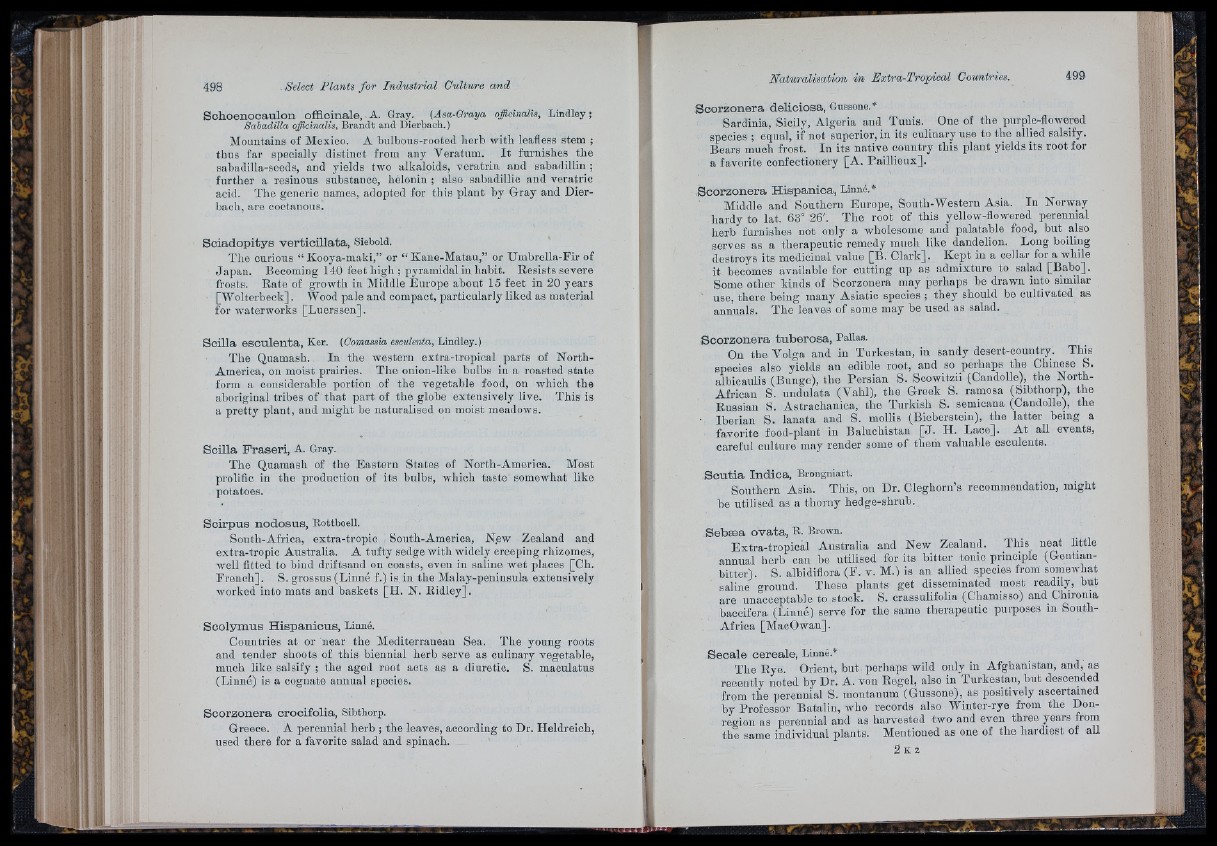
!■:
U
fi
i^- :
¥ 1- 1:1t î ■ li fr; 1 i= ..
1 I
' ' ilfr 1. !
Iii I
S c h o e n o c a u lo n o f f ic in a le ,• A. Gray. (Asa-Oraya oßciiialis, Lindley;
Sabadilla oßciualis, Brandt and Dierbach.)
Mountains of Mexico. A bulbous-rooted herb with leafless stem ;
thus far specially distinct from any Veratnm. I t furnishes the
sahadilla-seeds, and yields two alkaloids, veratrin and sabadillin ;
further a resinous substance, helonin ; also sabadillic and veratrio
acid. The generic names, adopted for this plant by Gray and Dierbach,
are coetanous.
S c i a d o p i ty s v e r tic iU a ta , Siebold.
The curious “ Kooya-maki,” or “ Kaiie-Matau,” or Umbrella-Fir of
Japan. Becoming 140 feet high ; pyramidal iu liabit. Resists severe
frosts. Rate of growth in Middle Europe about 15 feet in 20 years
[Wolterbeck]. Wood pale and compact, particularly liked as material
for waterworks [Luerssen].
S c illa e s c u le n ta , Ker. (Comassia esculenta, Lindley.)
The Quamash. In the western extra-tropioal parts of North-
America, on moist prairies. The onion-like bulbs in a roasted state
form a considerable portion of the vegetable food, on which the
aboriginal tribes of th a t part of the globe extensively live. This is
a pretty plant, and might be naturalised on moist meadows.
S c illa F r a s e r i , A. Gray.
The Quamash of the Eastern States of North-America. Most
proliflc iu the production of its bulbs, which taste somewhat like
potatoes.
S c i r p u s n o d o s u s , Rottboell.
South-Africa, extra-tropic South-America, New Zealand and
extra-tropic Australia. A tufty sedge with widely creeping rhizomes,
well fitted to bind driftsand on coasts, even iu saline wet places [Ch.
French]. S. grosses (Linné f.) is in the Malay-peninsula extensively
worked into mats aud baskets [H. N. Ridley].
S c o ly m u s H is p a n i c u s , Linné.
Countries a t or near the Mediterranean Sea. The young roots
and tender shoots of tliis biennial herb serve as culinary vegetable,
mncli like salsify ; the aged root acts as a diuretic. S. maculatus
(Linné) is a cognate annual species.
S c o r z o n e r a c ro c ifo lia , Sibthorp.
Greece. A perennial herb ; the leaves, according to Dr. Heldreich,
used there for a favorite salad and spinach.
S c o r z o n e r a d e lic io s a , Gussone.*
Sardinia, Sicily, Algeria and Tunis. One of the purple-flowered
species ; equal, if not superior, in its culinary use to the allied salsify.
Bears much frost. In its native country this plant yields its root for
a favorite confectionery [A. Paillieux].
S c o r z o n e r a H i s p á n ic a , Linné.*
Middle and Southern Europe, South-Western Asia. In Norway
hardy to lat. 63° 26'. The root of this yellow-flowered perennial
lierb famishes not only a wholesome and palatable food, hut also
serves as a therapeutic remedy much like dandelion. Long boiling
destroys its medicinal value [B. Clark]. Kept in a cellar for a while
it becomes available for cutting up as admixture to salad [Babo].
Some other kinds of Scorzonera may perhaps he drawn into similar
' use, there being many Asiatic species ; they should he cultivated as
annuals. The leaves of some may be used as salad.
S c o r z o n e r a tu b e r o s a , Pallas.
On the Volga aud in Turkestan, in sandy desert-country. This
species also yields an edible root, and so perhaps the Chinese S.
albicaidis (Bunge), the Persian S. Scowitzii (Candolle), the North-
African S. undulata (Vahl), the Greek S. ramosa (Sibthorp), the
Russian S. Astrachanica, the Turkish S. semicana (Candolle), the
■ Iberian S. lanata and S. mollis (Bieberstein), the latter being a
favorite food-plant in Baluchistan [J . H. Lace]. A t ail events,
careful culture may render some of tliem valuable esculents.
S o u t i a I n d ic a , Brongniart.
Southern Asia. This, on Dr. Cleghorn’s recommendation, might
he utilised as a thorny hedge-shrub.
S e b æ a o v a ta , B. Brown.
Extra-tropical Australia and New Zealand. This neat little
annual lierb can he utilised for its bitter tonic principle (Gentian-
bitter). S. albidiflora (F. v. M.) is an allied species from somewhat
saline ground. These plants get disseminated most readily, but
are unacceptable to stock. S. crassulifolia (Chamisso) and Chironia
baocifera (Linné) serve for the same therapeutic purposes m South-
Africa [MacOwan].
S e o a le c e r e a le , Linné.*
The Rye. Orient, but perhaps wild only in Afghanistan, and, as
recently noted by Dr. A. von Begel, also in Turkestan, but descended
from the perennial S. montanum (Gussone), as positively ascertained
by Professor Batalin, who records also Winter-rye from the Don-
regioii as perennial and as harvested two and even three years from
the same individual plants. Mentioned as one of the hardiest of all
2 K 2
fri ,